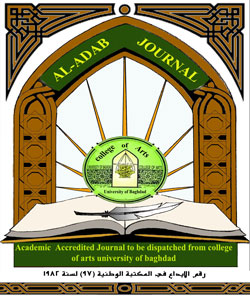The basic elements in planning Arab Islamic cities
DOI:
https://doi.org/10.31973/aj.v0i112.1469Keywords:
/Abstract
The Arabic-Islamic city planning was based on two main factors are a place of worship, housing, and there is always the trinity of religious, political, and economic are at the center of each city, such as mosque ,Dar Emirate and the market in addition to the spacious field. But many Arab countries have adopted Western ideas in architecture and planning, which led to blur features and elements of originality in the planning of Arabic-Islamic city.
many of the planners and engineers were adapted the Western ideas in architecture and planning until it became mainstream, And if it continues may lead to a change in values and the Arab community lose their recognized civilization and indelible personal characteristic.
I have addressed in this paper the originated of Arabic Islamic cities and study the basic elements in the planning and urban fabric of the component properties with a view to reaching elements of originality, which was characterized by the Islamic -Arab cities that can be used in the planning of contemporary Arabic city
Downloads
References
2. حسين ،عبد الرزاق عباس ،نشأت مدن العراق وتطورها ،جامعة بغداد ، مطبعة الارشاد ،1977 .
3. جعفر ،عصام عبد الامير محمد ، تطور المنطقة التجارية في مركز الرصافة القديمة –بغداد ،رسالة مقدمة الى كلية الهندسة المعمارية ،جامعة بغداد ،1986.
4. السعدوني ،رعد لفته ، المدينة العربية الاسلامية من منظور معماري وحضري ، رسالة ماجستير مقدمة الى جامعة بغداد/ كلية الهندسة المعمارية ،1990.
5. السرحان ،ميسون محي هلال ،التغير الوظيفي وتشكيل الجزء التقليدي، رسالة ماجستير مقدمة الى مركز التخطيط الحضري والاقليمي للدراسات العليا ،1999.
6. عثمان ،محمد عبد الستار ، المدينة الاسلامية ،سلسلة كتب ثقافية ، المجلس الوطني للثقافة والفنون والاداب ، الكويت ،1988.
7. الغزالي ، الشيخ محمد، عمارة المدينة المنورة في عهد الرسول (ص)،سلسلة دورية تصدر عن وزارة الثقافة ،قطر ،1996.
8. القادري،سلمى خالد،اشكالية النسيج الحضري للمدينة العربية الاسلامية،رسالة ماجستير مقدمة الى مركز التخطيط الحضري والاقليمي،2006.
9. الكناني ، عامر شاكر،التغير في النسيج العمراني واثره في المشهد الحضري ،رسالة ماجستير مقدمة الى مركز التخطيط الحضري والاقليمي ،2000.
10. الكناني ،كامل كاظم ،تخطيط المدينة العربية الاسلامية-الخصوصية والحداثة ،مجلة المخطط والتنمية، العدد 15،لسنة 2006.
11. مصطفى ، شاكر ، المدن في الاسلام حتى العصر العثماني ، الطبعة الاولى الجزء الاول ،1988.
12. مصطفى ، شاكر ، المدن في الاسلام حتى العصر العثماني ، الطبعة الاولى ،الجزء الثاني ،1988.
13. المدفعي ،قحطان،تطور تخطيط المدينة العربية ،المؤتمر الاول لمنظمة المدن العربية ،بيروت ،لبنان ،1986.
14. المظفر،رياض منير، فهم المدينة العربية الاسلامية بكونها نظاما في ضوء المتغيرات الاجتماعية والاقتصادية والتكنلوجية ،رسالة ماجستير مقدمة الى مركز التخطيط الحضري والاقليمي ،2005.
15. الموسوي ، مصطفى عباس ، العوامل التأريخية لنشأة وتطور المدن العربية الاسلامية ، بغداد ،دار الرشيد ،1982.
16. Ansari,J,H and Shaheer,M, Astrategy for Planning in Arab Town in the Arab City, Saudia Arabia, 1981.
17.Hakim,Basim Sasim, Arabic- Islamic Cities,Building and Planning Principle, KPILTD, England,1981
Downloads
Published
Issue
Section
License
Copyright and Licensing:
For all articles published in Al-Adab journal, copyright is retained by the authors. Articles are licensed under an open access Creative Commons CC BY 4.0 license, meaning that anyone may download and read the paper for free. In addition, the article may be reused and quoted provided that the original published version is cited. These conditions allow for maximum use and exposure of the work.
Reproducing Published Material from other Publishers: It is absolutely essential that authors obtain permission to reproduce any published material (figures, schemes, tables or any extract of a text) which does not fall into the public domain, or for which they do not hold the copyright. Permission should be requested by the authors from the copyrightholder (usually the Publisher, please refer to the imprint of the individual publications to identify the copyrightholder).
Permission is required for: Your own works published by other Publishers and for which you did not retain copyright.
Substantial extracts from anyones' works or a series of works.
Use of Tables, Graphs, Charts, Schemes and Artworks if they are unaltered or slightly modified.
Photographs for which you do not hold copyright.
Permission is not required for: Reconstruction of your own table with data already published elsewhere. Please notice that in this case you must cite the source of the data in the form of either "Data from..." or "Adapted from...".
Reasonably short quotes are considered fair use and therefore do not require permission.
Graphs, Charts, Schemes and Artworks that are completely redrawn by the authors and significantly changed beyond recognition do not require permission.
Obtaining Permission
In order to avoid unnecessary delays in the publication process, you should start obtaining permissions as early as possible. If in any doubt about the copyright, apply for permission. Al-Adab Journal cannot publish material from other publications without permission.
The copyright holder may give you instructions on the form of acknowledgement to be followed; otherwise follow the style: "Reproduced with permission from [author], [book/journal title]; published by [publisher], [year].' at the end of the caption of the Table, Figure or Scheme.












